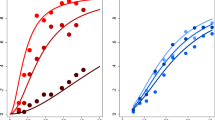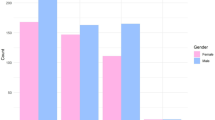Abstract
Background
The present study examined the association between 9/11-related adolescent behavioral problems on mental health outcomes in early adulthood.
Methods
Data from enrollees of the World Trade Center Health Registry, who completed at least one adolescent (2006–2007 or 2011–2012) and adult survey (2011–2012 or 2015–2016), were analyzed. Adolescent behavioral difficulties were assessed using the adolescent-reported Strengths and Difficulties Questionnaire (SDQ). Adult mental health outcomes included binge drinking, smoking status history, 9/11-related post-traumatic stress disorder (PTSD), depression, and the self-reported number of physician mental health diagnoses. Multivariable regression was used to estimate associations of SDQ scores with mental health outcomes.
Results
Of the 297 enrollees, 16.8% (n = 50) had abnormal/borderline SDQ scores as an adolescent. Binge drinking was not associated with adolescent SDQ scores. Enrollees with abnormal/borderline SDQ scores as an adolescent were more likely to be a consistent smoker (odds ratio (OR): 5.6, 95% confidence interval (CI): 1.2–25.2), have probable PTSD (OR: 3.5, 95% CI: 1.3–9.8), depression (OR: 6.2, 95% CI: 2.7–13.9), and to have two or more self-reported physician-diagnosed mental health conditions as an adult (OR 5.6, 95% CI: 2.0–12.5).
Conclusions
The findings of this study underscore the need to intervene early with children exposed to traumatic events so as to avert later adolescent and adult problem behaviors.
Similar content being viewed by others
Log in or create a free account to read this content
Gain free access to this article, as well as selected content from this journal and more on nature.com
or
References
Arnett, J. J. in Bridging Cultural and Developmental Approaches to Psychology: New Syntheses in Theory, Research, and Policy (ed. Jensen, L. A.) 255–275 (Oxford University Press, New York, NY, 2011).
Fergusson, D. M., Boden, J. M. & Horwood, L. J. Situational and generalised conduct problems and later life outcomes: evidence from a New Zealand birth cohort. J. Child Psychol. Psychiatry 50, 1084–1092 (2009).
Kim-Cohen, J. et al. Prior juvenile diagnoses in adults with mental disorder: developmental follow-back of a prospective-longitudinal cohort. Arch. Gen. Psychiatry 60, 709–717 (2003).
McGue, M. & Iacono, W. G. The association of early adolescent problem behavior with adult psychopathology. Am. J. Psychiatry 162, 1118–1124 (2005).
Reef, J., Diamantopoulou, S., van Meurs, I., Verhulst, F. & van der Ende, J. Child to adult continuities of psychopathology: a 24-year follow-up. Acta Psychiatr. Scand. 120, 230–238 (2009).
Rowe, R., Costello, E. J., Angold, A., Copeland, W. E. & Maughan, B. Developmental pathways in oppositional defiant disorder and conduct disorder. J. Abnorm. Psychol. 119, 726–738 (2010).
Bor, W., McGee, T. R., Hayatbakhsh, R., Dean, A. & Najman, J. M. Do antisocial females exhibit poor outcomes in adulthood? An Australian cohort study. Aust. N. Z. J. Psychiatry 44, 648–657 (2010).
Ferdinand, R. F. & Verhulst, F. C. The prediction of poor outcome in young adults: comparison of the Young Adult Self-Report, the General Health Questionnaire and the Symptom Checklist. Acta Psychiatr. Scand. 89, 405–410 (1994).
Fergusson, D. M., Horwood, L. J. & Ridder, E. M. Conduct and attentional problems in childhood and adolescence and later substance use, abuse and dependence: results of a 25-year longitudinal study. Drug Alcohol. Depend. 88(Suppl 1), S14–S26 (2007).
Guo, J., Hawkins, J. D., Hill, K. G. & Abbott, R. D. Childhood and adolescent predictors of alcohol abuse and dependence in young adulthood. J. Stud. Alcohol. 62, 754–762 (2001).
Odgers, C. L. et al. Female and male antisocial trajectories: from childhood origins to adult outcomes. Dev. Psychopathol. 20, 673–716 (2008).
Mrug, S. & Windle, M. Prospective effects of violence exposure across multiple contexts on early adolescents’ internalizing and externalizing problems. J. Child Psychol. Psychiatry 51, 953–961 (2010).
Yoon, S., Steigerwald, S., Holmes, M. R. & Perzynski, A. T. Children’s exposure to violence: the underlying effect of posttraumatic stress symptoms on behavior problems. J. Trauma. Stress 29, 72–79 (2016).
Lambert, S. F., Boyd, R. C., Cammack, N. L. & Ialongo, N. S. Relationship proximity to victims of witnessed community violence: associations with adolescent internalizing and externalizing behaviors. Am. J. Orthopsychiatry 82, 1–9 (2012).
O’Keefe, M. Adolescents’ exposure to community and school violence: prevalence and behavioral correlates. J. Adolesc. Health 20, 368–376 (1997).
Schwab-Stone, M. et al. No safe haven. II: the effects of violence exposure on urban youth. J. Am. Acad. Child Adolesc. Psychiatry 38, 359–367 (1999).
Cooley-Strickland, M. et al. Community violence and youth: affect, behavior, substance use, and academics. Clin. Child Fam. Psychol. Rev. 12, 127–156 (2009).
Masten, A. S. et al. Developmental cascades: linking academic achievement and externalizing and internalizing symptoms over 20 years. Dev. Psychol. 41, 733–746 (2005).
Chemtob, C. M., Nomura, Y., Josephson, L., Adams, R. E. & Sederer, L. Substance use and functional impairment among adolescents directly exposed to the 2001 World Trade Center attacks. Disasters 33, 337–352 (2009).
Gargano, L. M., Welch, A. E. & Stellman, S. D. Substance use in adolescents 10 years after the World Trade Center attacks in New York City. J. Child Adolesc. Subst. Abus. 26, 66–74 (2017).
Gargano, L. M., Dechen, T., Cone, J. E., Stellman, S. D., Brackbill, R. M. Psychological distress in parents and school-functioning of adolescents: results from the World Trade Center Registry. J. Urban Health 94, 597–605 (2017).
Gargano, L. M., & Locke, S. & Brackbill, R.M. Parent physical and mental health comorbidity and adolescent behavior. Int. J. Emerg. Ment. Health Human. Resiliance 19, 1–9 (2017).
Hoven, C. W. et al. Psychopathology among New York city public school children 6 months after September 11. Arch. Gen. Psychiatry 62, 545–552 (2005).
Thomas, P. A. et al. Respiratory and other health effects reported in children exposed to the World Trade Center disaster of 11 September 2001. Environ. Health Perspect. 116, 1383–1390 (2008).
Bourdon, K. H., Goodman, R., Rae, D. S., Simpson, G. & Koretz, D. S. The strengths and difficulties questionnaire: U.S. normative data and psychometric properties. J. Am. Acad. Child Adolesc. Psychiatry 44, 557–564 (2005).
Blanchard, E. B., Jones-Alexander, J., Buckley, T. C. & Forneris, C. A. Psychometric properties of the PTSD Checklist (PCL). Behav. Res. Ther. 34, 669–673 (1996).
Kroenke, K., Spitzer, R. L. & Williams, J. B. The PHQ-9: validity of a brief depression severity measure. J. Gen. Intern. Med. 16, 606–613 (2001).
Substance Abuse and Mental Health Services Administration (SAMHSA). Binge Drinking: Terminology and Patterns of Use https://www.samhsa.gov/capt/tools-learning-resources/binge-drinking-terminology-patterns (2016).
Liao, Y. et al. Brief report: Examining children’s disruptive behavior in the wake of trauma - A two-piece growth curve model before and after a school shooting. J. Adolesc. 44, 219–223 (2015).
Pfefferbaum, B. et al. Exposure and peritraumatic response as predictors of posttraumatic stress in children following the 1995 Oklahoma City bombing. J. Urban Health 79, 354–363 (2002).
Pfefferbaum, B. et al. Posttraumatic stress responses in bereaved children after the Oklahoma City bombing. J. Am. Acad. Child Adolesc. Psychiatry 38, 1372–1379 (1999).
Giannakopoulos, G. et al. Emotional, behavioural problems and cigarette smoking in adolescence: findings of a Greek cross-sectional study. Bmc. Public. Health 10, 57 (2010).
Chassin, L., Presson, C. C., Rose, J. S. & Sherman, S. J. The natural history of cigarette smoking from adolescence to adulthood: demographic predictors of continuity and change. Health Psychol. 15, 478–484 (1996).
DeWit, D. J., Adlaf, E. M., Offord, D. R. & Ogborne, A. C. Age at first alcohol use: a risk factor for the development of alcohol disorders. Am. J. Psychiatry 157, 745–750 (2000).
Prescott, C. A. & Kendler, K. S. Age at first drink and risk for alcoholism: a noncausal association. Alcohol. Clin. Exp. Res. 23, 101–107 (1999).
Funding
This publication was supported by Cooperative Agreement Number 5U50/OH009739 and 5U50/OH009739 from the National Institute for Occupational Safety and Health (NIOSH) of the Centers for Disease Control and Prevention (CDC); U50/ATU272750 from the Agency for Toxic Substances and Disease Registry (ATSDR), CDC, which included support from the National Center for Environmental Health, CDC; and by the New York City Department of Health and Mental Hygiene (NYC DOHMH).
Author information
Authors and Affiliations
Corresponding author
Ethics declarations
Competing interests
The authors declare no competing interests.
Additional information
Publisher's note: Springer Nature remains neutral with regard to jurisdictional claims in published maps and institutional affiliations.
Rights and permissions
About this article
Cite this article
Gargano, L.M., Locke, S., Li, J. et al. Behavior problems in adolescence and subsequent mental health in early adulthood: results from the World Trade Center Health Registry Cohort. Pediatr Res 84, 205–209 (2018). https://doi.org/10.1038/s41390-018-0050-8
Received:
Revised:
Accepted:
Published:
Issue date:
DOI: https://doi.org/10.1038/s41390-018-0050-8
This article is cited by
-
Paternal Incarceration and Adolescent Delinquency: Role of Father Engagement and Early Child Behavior Problems
Prevention Science (2024)
-
Depression in Youth Exposed to Disasters, Terrorism and Political Violence
Current Psychiatry Reports (2019)



